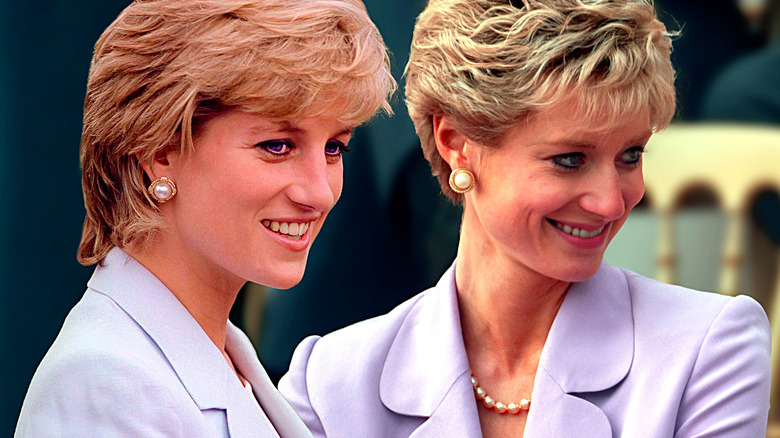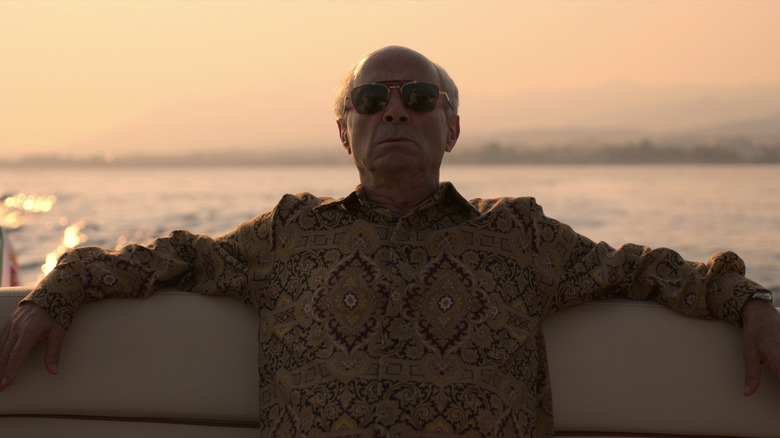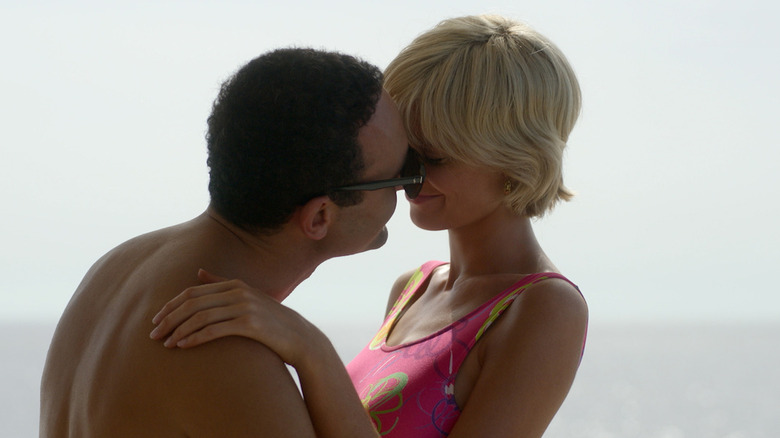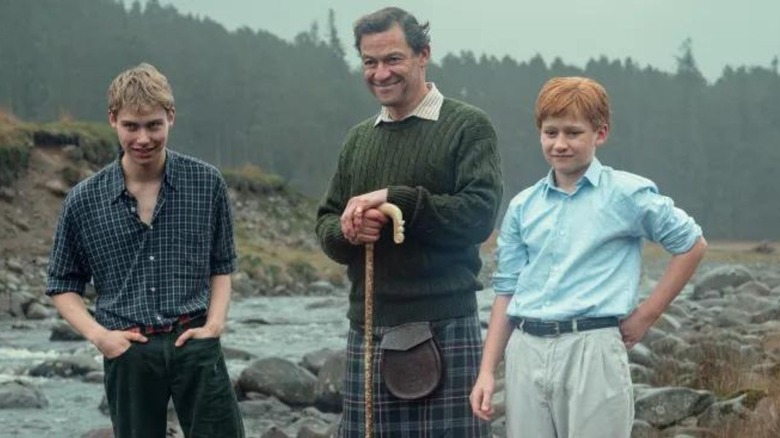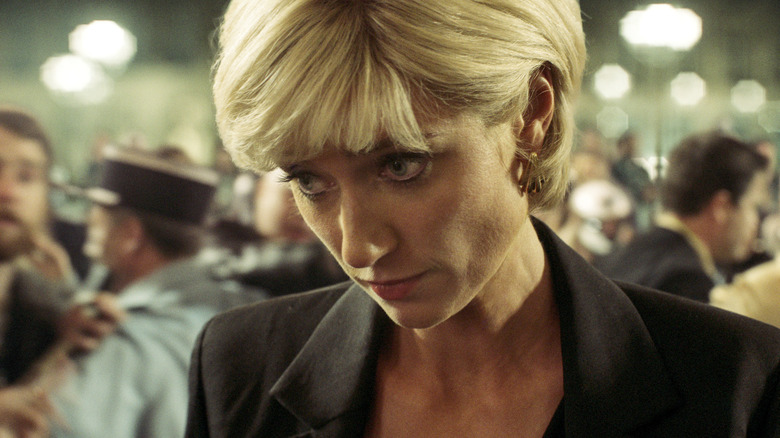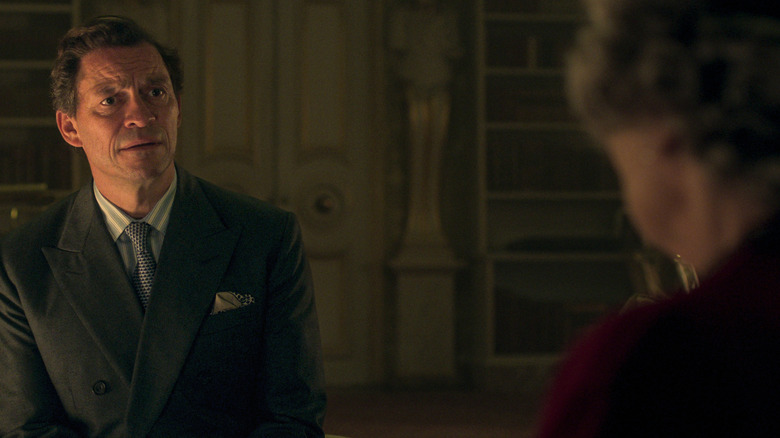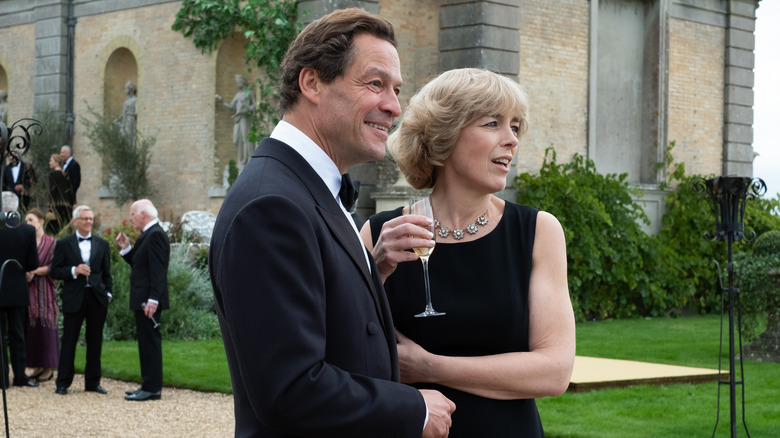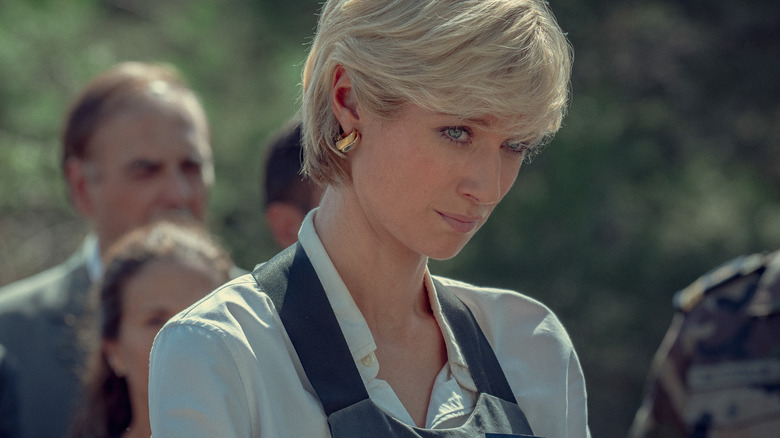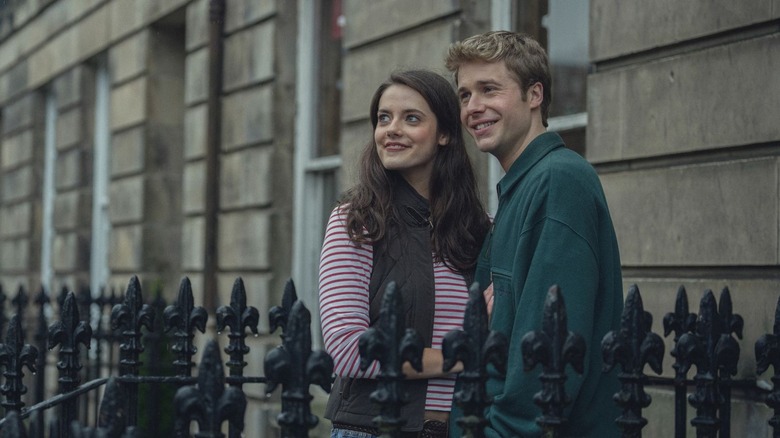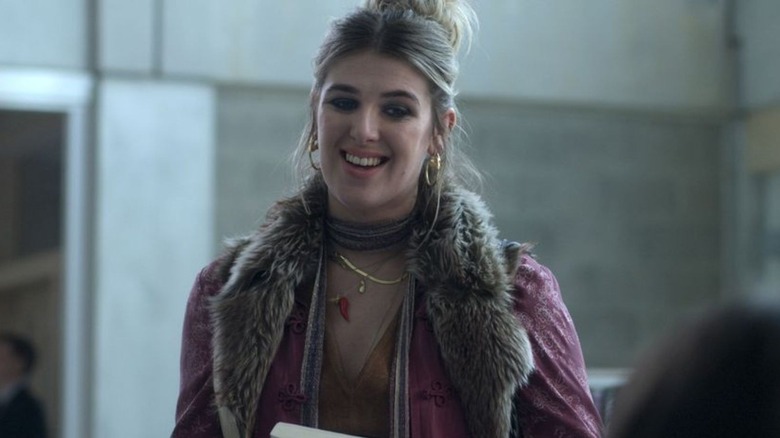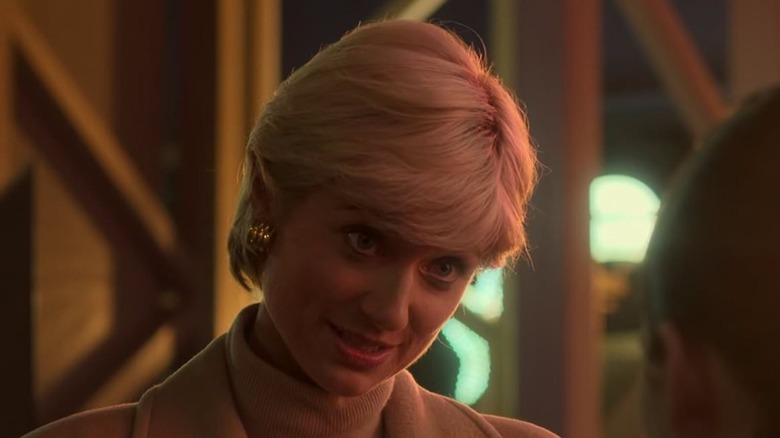Things The Crown Season 6 Got All Wrong About The True Story
Netflix has finally brought its critically acclaimed historical drama series "The Crown" to an end, closing the curtain on an epic that spanned several different decades, rulers, wars, and lovers. Developed by frequent royal dramatizer Peter Morgan (the scribe behind the film "The Queen" and the play "The Audience," both of which examine similar subject matter to the Netflix series), it valiantly strove to turn Queen Elizabeth's rise to power into must-watch, bingeable television. For the most part, it succeeded — though certain liberties apparently had to be taken with the true story of the late monarch.
"The Crown" has a mixed reputation when it comes to historical accuracy. Some changes are fairly mundane — for example, the writers may use historical context to imagine a feasible private interaction between characters that, in reality, could not have been physically documented. On the other hand, other changes have been controversial — mostly those wherein the series uses its historical authority to present speculation as fact. Here are some of the biggest missteps from the final season of "The Crown."
The Al-Fayed family has denied manufacturing Dodi Fayed's relationship with Princess Diana
In Season 6, Part 1 of "The Crown," audiences were reintroduced to the series' dramatization of the Al-Fayeds, the Egyptian family whose fate would become tragically intertwined with the British royal family. If you take the Netflix drama at its word, you will undoubtedly be left with the impression that the widely publicized love affair between Dodi Fayed and Diana, Princess of Wales (played by Khalid Abdalla and Elizabeth Debicki in the series) was orchestrated by Dodi's father — the late billionaire businessman Mohamed Al-Fayed (Salim Daw), who passed away at the age of 94 just a few months before the final season of "The Crown" premiered.
The implied motivation behind Al-Fayed's scheme in "The Crown" is his desire to secure citizenship in the United Kingdom, where he would begin to develop significant business interests (by the time of his death, Al-Fayed had bought and sold the famous luxury department store Harrods and the Fulham Football club). Speaking to Newsweek, Royal biographer and friend to Al-Fayed Robert Jobson described the storyline as "disrespectful," specifically slamming the idea that Al-Fayed orchestrated the romance as a ploy for U.K. citizenship as "bull****."
"To be honest he told me he'd never get [citizenship] and he knew that as well," Jobson said. "He wanted his son to be happy. He loved his son. He adored his family." Allegations of this kind have been made and denied since 1997, as former Al-Fayed spokesperson Michael Cole knows all too well. Cole told Deadline that he never witnessed anything supporting this narrative, and dismissed "The Crown" as a "made up" fiction.
There's also no evidence Mohamed Al-Fayed hired a photographer to capture Dodi Fayed and Princess Diana's kiss
In the series, part of Mohamed Al-Fayed's depicted plot to ensure his son's romance with Diana was hiring "the best [paparazzi] photographer on the Mediterranean" to capture Dodi Fayed's wooing of the Princess of Wales. However, that fateful picture — captured by Italian photographer Mario Brenna — has widely disputed origins, with it initially being attributed to Brenna being in the right place at the right time. Brenna himself maintains to this day that capturing the moment was simply a "great stroke of luck," and refutes his portrayal as having collaborated with Al-Fayed as "absurd and completely fabricated" (per an interview with the New York Times).
Of course, there's an understandable level of skepticism surrounding such a claim, but to outright portray Al-Fayed as hiring Brenna stretches credibility beyond even what most skeptics believe. Tina Brown — a British journalist and Royal biographer with a somewhat dubious reputation for trafficking in gossip and rumors — propagated the unsubstantiated claim that Al-Fayed orchestrated Dodi and Diana's relationship for personal gain in her book "The Diana Chronicles." Yet even she doesn't seem to buy the theory that Al-Fayed hired or otherwise tipped off Brenna, instead offering that Diana herself leaked the meet-up to the press to "send a taunting message" (in Brown's words) to her ex-beau Hasnat Khan. Charles Rae (formerly of the British tabloid The Sun) claims Brenna told him he was called to take the photo, though has allegedly never divulged who contacted him.
Prince Charles and his sons were not photographed by a family friend to compete with Princess Diana's kiss
After Mohamed Al-Fayed successfully leaked photos of his child cozying up to the Princess of Wales, "The Crown" includes a sequence in which Prince Charles (Dominic West) arranges for a photograph to be taken of him and their young children, Harry and William, on the grounds of Balmoral Castle in Scotland. Charles hires a family friend for the shoot, which would ultimately appear on the front page of The Mirror, successfully pushing the painful image of his wife and her new lover out of the spotlight for at least a day.
This is not at all how this sequence transpired in real life. First, and most glaringly, "Duncan Muir" — a friend of the family who's supposed to have captured the image — doesn't seem to have existed, and even if he did, he certainly was not responsible for Charles' Scottish family photo. Instead, Charles invited an army of photographers from various British papers to take a picture of him and his sons (by no means was the image a "royal exclusive" as seen on the show). Surprisingly, the depiction of Charles' photo having landed the front page of The Mirror is also verifiably untrue — in fact, the front page story the day The Mirror published the photo (eight pages into the issue, no less) was about Princess Diana and Dodi Fayed.
Princess Diana wasn't merely paranoid about potential wiretapping
Elizabeth Debicki's Diana is depicted in "The Crown" as being suspicious that her calls were being surveilled. While it's true that Diana held these suspicions, the show makes no moves to validate them even implicitly — when the real Diana had been surveilled via wiretaps, potentially by governments on both sides of the pond.
Following the denial of a Freedom of Information Act request in 1998, the National Security Agency (NSA) of the U.S. admitted to having a file on Diana, Princess of Wales, that came as the result of a multi-year blanket surveillance campaign. The file reportedly consists of over 1,000 pages of entries, all of which remain classified. (NSA officials reassured the public at the time that there was nothing "targeted" about its surveillance of Diana — she was merely one of the millions of normal citizens unknowingly eavesdropped upon by the agency. Quite reassuring indeed.)
It's also worth noting that in 1992, a 20-minute phone conversation between Diana and her lover, James Gilbey, was leaked to the press under incredibly bizarre circumstances. Though reports at the time claimed amateur radioists had managed the record and leaked the call, it has since been reasonably theorized that Britain's highly secretive Government Communications Headquarters (GCHQ) was actually responsible.
Princess Diana's funeral arrangements were less contentious than depicted
In the aftermath of Princess Diana's tragic death in the series, "The Crown" depicts a bristling, occasionally outright contentious air between her ex-husband Prince Charles (Dominic West) and his mother Queen Elizabeth II (Imelda Staunton). One moment, in particular, sees Charles accuse the late monarch of distastefully being willing to allow Diana's body to be brought home in a "Harrod's van" rather than an aircraft, as would be customary for fallen members of the royal family. This struck a strong, false chord with Dickie Arbiter, the Queen's former press secretary, who widely criticized the series for taking extensive dramatic liberties at the expense of the royals.
Arbiter called the specific portrayal of Charles and Elizabeth's relationship following Diana's death "absolute nonsense" when speaking to Deadline. "It just didn't happen like that," he told the outlet. "Of course an aircraft was going to be made available [to bring her body home from France]. The Queen was the first one to agree to that." He also took issue with the series' depiction of the Queen as having decided to open Diana's funeral to the public, when — according to him — Diana's brother, Charles Spencer (not to be confused with her royal ex-husband) made that decision. "[Charles] Spencer thought that because Diana was a public figure, because she was very popular and people adored her, that it should be something handled by the royal family to make it a public event rather than a private family event," he told Deadline.
Prince Charles was likely less interested in his mother attending Camilla's 50th birthday dinner
Another contentious sequence depicted between Prince Charles and Queen Elizabeth in Season 6 of "The Crown" is his plea for his mother to attend the 50th birthday dinner of his new wife, Camilla Parker Bowles (Olivia Williams). As presented in the series, Charles eagerly wants Elizabeth's blessing on the union and sees the dinner as a chance for his mother to show her approval. This would contradict other accounts of this period of Charles and Elizabeth's relationship, which paint a much more frigid and mutually disinterested picture.
According to The Times, Prince Charles' biographers maintain that the heir apparent was just as frustrated with his mother as she was with his decision to divorce and re-marry. As such, it would be unlikely that Charles invited her to Camilla's birthday, much less expended the effort seen in the show. What we do know for certain is that the scene is a pure invention on the writers' part, as there's no evidence one way or the other that Queen Elizabeth was invited. Someone who absolutely wasn't invited, however, is Princess Margaret (Lesley Manville), whom "The Crown" features in attendance at the party.
Princess Diana's anti-landmine press conference took place before the media frenzy surrounding her and Dodi Fayed
Ever one of "The Crown's" favorite antagonists, journalists are portrayed as having completely derailed Princess Diana's anti-landmine press conference in Bosnia with questions about her affair with Dodi Fayed. Though the media eventually became dangerously obsessed with her and Dodi's relationship and this exact press conference did indeed take place in 1997, there's no evidence to suggest that it devolved into questions about Fayed as is depicted by the series.
Furthermore, while the media was already prying into Diana's personal life as a consequence of her royal status, this press conference took place before Mario Brenna's infamous picture was publicized. This photo is generally agreed to be what began the tabloids' focus on the Princess' relationship with Fayed, making it extremely unlikely that they were badgering her with questions about their relationship during the Bosnian press conference.
Prince William probably wasn't separated from the Golden Jubilee festivities
The same year of Queen Elizabeth's Golden Jubilee, her sister Princess Margaret died of a stroke at the age of 71. A month after this tragedy, their mother, also called Elizabeth, the Queen Mother, passed away at the age of 101. As Prince Harry notes in his autobiography "Spare," it was a bizarre year to be in the royal family, as celebrations were just as abundant, obligatory, and publicized as opportunities to mourn. But as he also recounts, he and his brother Prince William were essentially a unit, being escorted between events to the point of near delirium.
In "The Crown," William is depicted as having watched the celebrations of the Golden Jubilee with Kate Middleton (Meg Bellamy) and her family. Harry specifically notes of the time that "Willy and I were constantly pulling on another set of smart clothes, jumping into another black car, rushing to yet another venue for another party or parade, reception or gala." Meanwhile, there's no record that William and Kate were together during this time, making it yet another scene from Season 6 that — while technically feasible — is likely born of the writers' imagination.
Lola Kincaid is not a real person (though she may be based on one)
Probably the easiest of "The Crown" Season 6's fabrications to debunk is Prince William's romance with Lola Airdale-Cavendish-Kincaid (played by Honor Swinton Byrne). In the series, Lola is William's all-too-posh girlfriend whom he slowly drifts away from as his feelings for Kate Middleton develop. Lola comes from a rich family, like William, and is arguably a more sensible partner for the heir to the throne. Lola is also, coincidentally, entirely made up.
There was no Lola Airdale-Cavendish-Kincaid, and the various scenes between her and William during her singular episode in Part 2 are completely fictional. An argument has been made by many critics that Lola represents a kind of emotional-slash-psychological truth in the context of the show, serving as a conduit for conveying the real relationships William had before Kate (and, perhaps more abstractly, the sort of marriage he was turning his back on). One of William's girlfriends did have three prestigious last names, though it would probably be unfair to attribute the unflattering Lola entirely to her.
Kate Middleton never met Princess Diana
Finally, arguably the ultimate factual deviation included in "The Crown" involves Kate Middleton meeting her future mother-in-law, Diana, Princess of Wales. As the series imagines (though the sequence is very real in this dramatized continuity), Kate happens upon Diana selling magazines for charity. The two share a brief exchange, during which Kate catches a glimpse of William and subsequently develops a crush on him (the series shows Kate hanging a poster of him on her wall afterward, though that part may actually be true).
Though it's chronologically credible that Diana and Kate could have both existed in the same space at the same time during this period, we surely would have heard about such a meeting by this point had it occurred — it's too big a coincidence for the media to have ignored. Ultimately, it is a fact that the two never met — Kate explicitly said so herself during an interview with Today earlier this year. Why Peter Morgan would take such extraordinary liberties in this or any of the other circumstances on this list is anyone's guess. If nothing else, he is first and foremost a storyteller, not a historian — and, to paraphrase Mark Twain, one should never let the truth get in the way of a good story.
